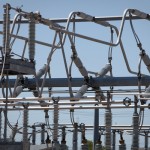Why Coal is On the Decline in Texas

Photo by Justin Sullivan/Getty Images
A coal miner at a Mitt Romney campaign rally at American Energy Corportation on August 14, 2012 in Beallsville, Ohio.
One of the few coal power plants still being planned in Texas is facing setbacks.
The controversial White Stallion Energy Center in Matagorda County had been working with the Texas grid to examine how it will work once its completed, a process called a grid interconnection study. It’s a typical requirement for new power plants, along with an air permit. But earlier this fall the Electric Reliability Council of Texas (ERCOT) cancelled that study.
“That process has taken longer than we anticipated,” Randy Bird, the Chief Operating Officer for the coal power project. “And most of the delay was on our side. Because of market conditions.”
Those market conditions are making coal power unattractive in Texas, and the nation. Low prices for natural gas (thanks to the widespread adoption of hyrdaulic fracturing, or “fracking”) and declining accessibility and quality of domestic coal have made natural gas the preferred option for new power.
“Coal has always been very affordable, reliable, and available,” says Scott Tinker, an energy professor at the University of Texas at Austin. “Well, now natural gas is affordable, reliable, and available as well. Almost all of the electric companies now are building new natural gas plants instead of coal.”
Tinker cites some figures: In 2004, over fifty percent of the electricity in the U.S. was generated by burning coal, while twenty percent came from natural gas. As of April this year, the two fuels became even. “It’s an unbelievably fast change,” Tinker says. “Economics can drive things quickly.”
White Stallion’s Bird says the coal plant is still going to go forward. He plans to start construction next year. He says the plant will be cleaner than existing coal plants, and use less water. “The grid in Texas, the customers need our power, ” Bird says. Under their current air permit, White Stallion has until the end of next year to begin construction.
But environmental groups are saying the project is likely finished.
“I think they have a lot of hurdles in front of them,” says Al Armendariz, Senior Representative for the Sierra Club’s Beyond Coal campaign and former regional head of the Environmental Protection Agency. Armendariz says that in addition to White Stallion’s grid connection study being cancelled, their air permit is currently being contested in court. And the project has faced issues securing water for the plant.
It’s similar for other coal projects in the state. In July, the Las Brisas coal power project in Corpus Christi had its air permit remanded, a major setback. And another petroleum coke power plant in the region allowed its permit to start construction expire in February.
At this point, there’s only one coal power plant scheduled to come online in the next few years, called Sandy Creek. It faced its own delays after an accident and isn’t expected to start running until next year.
“I’m pretty confident that we’re not going to see the construction of any new coal plants in Texas,” says Armendariz. “I think the Sandy Creek plant might very well be the last coal project that is ever built in the state of Texas.”
But while coal is fading in the Texas and the U.S., that’s not true for much of rest of the world. And that worries climate watchers like Professor Tinker.
“China builds a new coal power plant every eight days. Every eight days. So fifty a year. India is following that somewhat. And even places that have put a moratorium on fracking and nuclear are now looking back towards coal,” Tinker point out. “So you’re still seeing an aggregate increase in coal power production globally as result of that, and the emissions that go along with it.”
And the coal that was once mined for burning here in the U.S. isn’t just sitting around. Coal exports from the U.S. are on track to reach record highs, and with much of that going to Europe.
And while carbon emissions in the country are on a decline thanks to a natural gas boom (and less fuel used during the recession), that hasn’t been the case globally. Worldwide, carbon emissions rose 3 percent last year, which will make it nearly impossible to stem global climate change in the near future.
The lead emitter last year? China, with ten billion tons of carbon dioxide, ten percent higher than the year before.

